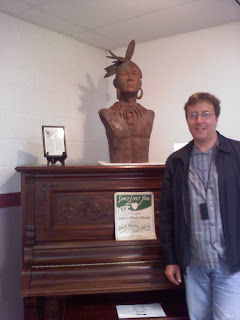 |
| LT on the Ohio River |
So what's with the name anyway? "LittleTurtle" does not sound like the name of a fierce warrior and brilliant military strategist. Little Turtle was not a small man either. In fact, he was six feet tall by all accounts. The name, per historical author J.P. Dunn, comes from a literal translation of his Miami name by English interpreters. His name in Miami, Michikinikwa, was the word for the painted terrapin which is a small colorful turtle. The turtle figured prominently in Algonquin symbolism and generally represented the Earth. The English interpreters had no word for this particular type of turtle so they just started referring to him as Little Turtle. You have to admit that Michikinikwa is a bit of a mouthful to say, especially for a bunch of white people who likely didn't finish 8th grade.
 |
| LT on a piano |
This boosted morale was short-lived and Little Turtle knew that the odds were against his people as the wave of American settlers increased and direct British support waned. Outright extinction of his people was a real possibility. He grudgingly negotiated peace with the Americans. Some of the other tribes led by the Shawnee Blue Jacket went on to fight and lose at Fallen Timbers against General Wayne. This battle resulted in the confederation of Indians signing the Treaty of Greenville in 1795 which gave most of Ohio to the Americans.
 |
| LT in a painting |
Little Turtle became a celebrity with European-Americans in his later years and traveled East where he met Presidents Washington, Jefferson, and Adams. It was his 1808 meeting with Jefferson, an expert in agriculture himself, where he was encouraged to introduce Western farming methods to his people. The famous lithograph of Little Turtle and only known likeness of him is based upon a lost portrait by Gilbert Stuart, at the request of President George Washington. The original was destroyed when the British burned Washington, D.C. in 1814 during the War of 1812.
On the surface, these new developments sounded promising. However, Native Americans could change their religion, way of life and their style of clothing but they could not change their skin color or distinct features and were still Indian savages as far as most Americans were concerned. Little Turtle signed several more land treaties over these years that proved to be unpopular with the Miami and the neutrality of the Miami tribe still did not protect his tribespeople from American attacks. As a result of this his respect within his tribe diminished and in 1809 lost his status as war chief while Miami leadership went to others.
 |
| early 19th-century lithograph of LT |
His grave location was neglected and lost to time until a home builder in the early 20th century discovered a bunch of skeletons along with some artifacts. Among the recovered artifacts was the very sword that was presented to Little Turtle by George Washington which is now in a museum.

